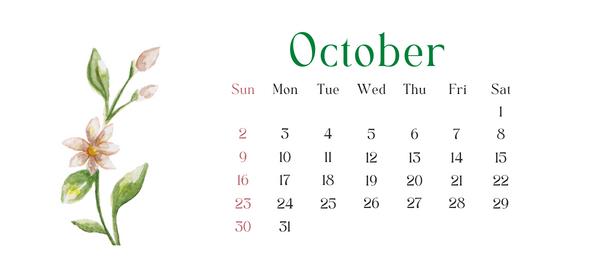
Foraging Calendar: What to Forage in October
It’s October, time for pumpkin picking, trick or treating, and some foraging underneath those stunning color-changing leaves. I love putting on a fuzzy sweater and heading out to pick rosehips and pine needles to make a lovely tea to sip on in front of the fire.
The USDA Hardiness zone Map is an attempt to divide the country into zones that give us some idea whether certain plants can be grown in any given area. The primary piece of data used to delineate the zones is the average annual winter temperature experienced in that area. This could just be a list of forageables but the temperature varies so much across the U.S.A. The Lost Herbs wants this to be a list for every one of our readers no matter the zone or region you live in.
Australia lies in Plant Hardiness Zones 7 through 12 with some variations across regions and seasons. The caveat with foraging in Australia is it is completely illegal without a permit. Without the 104$ permit you can be fined anywhere from 10,000 to 110,000 dollars depending on where you foraged. If you have a license or are on your own land you can forage freely. Canada’s weather aligns more with the United states and many of the plants above can grow in Canada’s ecosystem. Canadians can use the hardiness zones to apply to their regions.
Here are some forageables to pick after you drink your pumpkin spice latte.
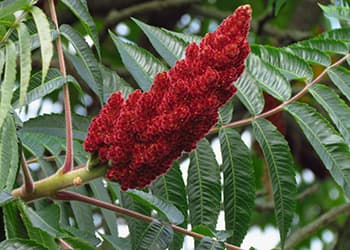 Staghorn Sumac (Rhus typhina) Staghorn sumac trees are short between five and 15 feet tall with pointed leaves. The berries grow in red clusters. Sumac berries can be eaten raw or dried and are used as a tonic to increase appetite or treat coughs. Staghorn sumac grows in hardiness zones 5-8 and grows in the Midwest and Northeast regions of the U.S. in October.
Staghorn Sumac (Rhus typhina) Staghorn sumac trees are short between five and 15 feet tall with pointed leaves. The berries grow in red clusters. Sumac berries can be eaten raw or dried and are used as a tonic to increase appetite or treat coughs. Staghorn sumac grows in hardiness zones 5-8 and grows in the Midwest and Northeast regions of the U.S. in October.
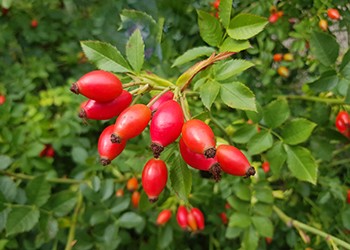 Rose Hips (Rosa canina) are the fruit of any rosebush. All Rose hips are edible; they can vary in color from vibrant red or orange to purple or black. Rose hips make great jellies, sauces, syrups, soups and seasoning, and even fruit leather. Rose Hips grow in hardiness zones 3-9 and grow in all regions of the U.S. in October.
Rose Hips (Rosa canina) are the fruit of any rosebush. All Rose hips are edible; they can vary in color from vibrant red or orange to purple or black. Rose hips make great jellies, sauces, syrups, soups and seasoning, and even fruit leather. Rose Hips grow in hardiness zones 3-9 and grow in all regions of the U.S. in October.
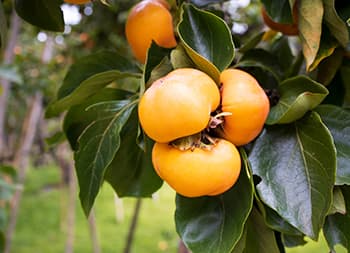 Persimmon (Diospyros virginiana) trees are dark gray-brown with scaly bark. The leaves alternate, simple, four to six inches long, oval, narrowed, or rounded, and turn yellowish orange in the fall. The fruit is round or oval and usually orange-yellow, sometimes bluish, and from 2 to 6 cm in diameter. Persimmons can be eaten raw like an apple or dried in tea. Persimmons grow in hardiness zone 4-9 and they grow in all regions of the U.S. except the West.
Persimmon (Diospyros virginiana) trees are dark gray-brown with scaly bark. The leaves alternate, simple, four to six inches long, oval, narrowed, or rounded, and turn yellowish orange in the fall. The fruit is round or oval and usually orange-yellow, sometimes bluish, and from 2 to 6 cm in diameter. Persimmons can be eaten raw like an apple or dried in tea. Persimmons grow in hardiness zone 4-9 and they grow in all regions of the U.S. except the West.
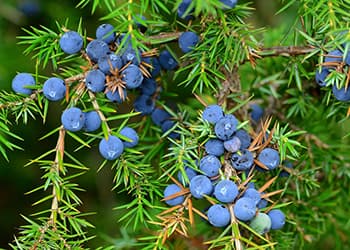 Juniper berries (Juniperus communis ) leaves have a glossy green lower surface and a bluish-green upper surface. Leaves are borne in whorls of three. The berries are commonly a blue color with a white bloom of wild yeast. The best way to determine this is to taste a tiny bit of a berry and if it is harsh and bitter spit it out and do not ingest it internally. Don’t worry, they are only mildly toxic so a tiny nibble isn’t a problem in this case. Juniper berries are rarely eaten raw but are used as a spice or to make wine/mead. They grow in hardiness zones 2-7 and in the Northeast, Midwest, and West regions of the U.S.
Juniper berries (Juniperus communis ) leaves have a glossy green lower surface and a bluish-green upper surface. Leaves are borne in whorls of three. The berries are commonly a blue color with a white bloom of wild yeast. The best way to determine this is to taste a tiny bit of a berry and if it is harsh and bitter spit it out and do not ingest it internally. Don’t worry, they are only mildly toxic so a tiny nibble isn’t a problem in this case. Juniper berries are rarely eaten raw but are used as a spice or to make wine/mead. They grow in hardiness zones 2-7 and in the Northeast, Midwest, and West regions of the U.S.
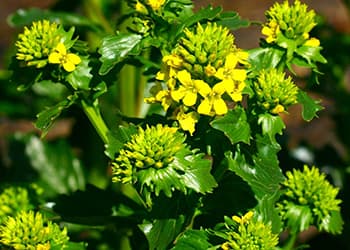 Wintercress (Barbarea vulgaris) grows in a green rosette with the leaves alternating along the stem. The leaves are wedge-shaped at the bottom and toothy at the top. They bloom beautiful vibrant yellow flowers in clusters on the top. Wintercress is used to make medicinal teas or cooked for a nice side dish. Wintercress grows in hardiness zones 3-7 and Northeast, Midwest, and West regions of the U.S.
Wintercress (Barbarea vulgaris) grows in a green rosette with the leaves alternating along the stem. The leaves are wedge-shaped at the bottom and toothy at the top. They bloom beautiful vibrant yellow flowers in clusters on the top. Wintercress is used to make medicinal teas or cooked for a nice side dish. Wintercress grows in hardiness zones 3-7 and Northeast, Midwest, and West regions of the U.S.
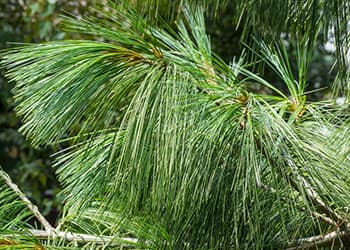 White Pine (Pinus strobus) like any pin has needles, which have a long, soft, velvety, blue-green appearance growing in bundles of 5. These pines grow anywhere from 50-100 feet with red-brown scaly bark. The pine needles can be used to flavor syrups, teas and jellies. Eastern White Pines grow in hardiness zones 3-8 and in the Northeast and Midwest regions of the U.S.
White Pine (Pinus strobus) like any pin has needles, which have a long, soft, velvety, blue-green appearance growing in bundles of 5. These pines grow anywhere from 50-100 feet with red-brown scaly bark. The pine needles can be used to flavor syrups, teas and jellies. Eastern White Pines grow in hardiness zones 3-8 and in the Northeast and Midwest regions of the U.S.
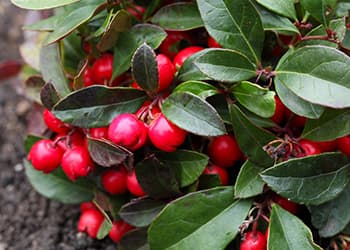 Teaberry (Gaultheria procumbens) is a creeping shrub with white bell-shaped flowers, spicy red fruits, and aromatic shiny leaves. Teaberries certainly aren’t the best raw but they are wonderful to add flavor to wine or even ice cream. The leaves give a spicy odor when crushed. Teaberries grow in hardiness zones 3-8 and in the Northeast, Southeast, and Midwest regions of the U.S.
Teaberry (Gaultheria procumbens) is a creeping shrub with white bell-shaped flowers, spicy red fruits, and aromatic shiny leaves. Teaberries certainly aren’t the best raw but they are wonderful to add flavor to wine or even ice cream. The leaves give a spicy odor when crushed. Teaberries grow in hardiness zones 3-8 and in the Northeast, Southeast, and Midwest regions of the U.S.
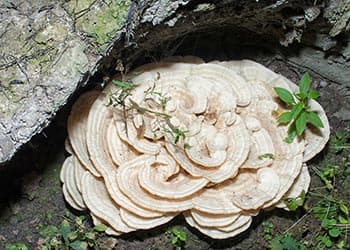 Berkeley Polypore (Bondarzewia berkeleyi) grows in rosettes or clusters of fleshy, cream-colored caps, with whitish pores that descend the stalk. Berkeley polypores grow on dead hardwood trees or at the base of living hardwood trees. Berkeley Polypore can be sautéed or dried for delicious soups. This polypore grows in hardiness zones 3-7 and in the Northeast, Southeast and Midwest regions in the U.S.
Berkeley Polypore (Bondarzewia berkeleyi) grows in rosettes or clusters of fleshy, cream-colored caps, with whitish pores that descend the stalk. Berkeley polypores grow on dead hardwood trees or at the base of living hardwood trees. Berkeley Polypore can be sautéed or dried for delicious soups. This polypore grows in hardiness zones 3-7 and in the Northeast, Southeast and Midwest regions in the U.S.
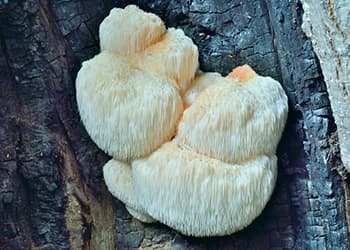 Lion’s Mane (Hericium Erinaceus) is white and can be identified by its icicle-like teeth hanging from the central stalk. They grow on hardwood. There are no poisonous look-alikes of Lion’s mane. Lion’s Mane is used in many dishes and often used for imitation crab or fish. They grow in hardiness zones 5-9 and in the Southeast, Southwest, and West regions of the U.S.
Lion’s Mane (Hericium Erinaceus) is white and can be identified by its icicle-like teeth hanging from the central stalk. They grow on hardwood. There are no poisonous look-alikes of Lion’s mane. Lion’s Mane is used in many dishes and often used for imitation crab or fish. They grow in hardiness zones 5-9 and in the Southeast, Southwest, and West regions of the U.S.
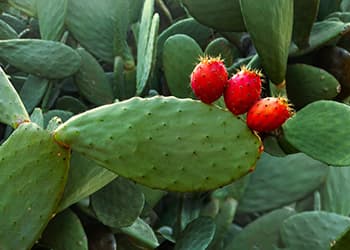 Prickly Pear (Opuntia ficus-indica) are easily recognized by their flat paddle-shaped stem segments called cladodes that grow one on top of the other. The flowers are typically yellow, sometimes pink, and rarely white or anywhere in between these colors. The fruit can be vibrant pink to green. The fruit is used in jams or eaten raw. Be careful of this cactus’ paddle’s because they can have long sharp spines. Opuntia grows in hardiness zone 9-11 and in the Southwest and West Regions of the U.S.
Prickly Pear (Opuntia ficus-indica) are easily recognized by their flat paddle-shaped stem segments called cladodes that grow one on top of the other. The flowers are typically yellow, sometimes pink, and rarely white or anywhere in between these colors. The fruit can be vibrant pink to green. The fruit is used in jams or eaten raw. Be careful of this cactus’ paddle’s because they can have long sharp spines. Opuntia grows in hardiness zone 9-11 and in the Southwest and West Regions of the U.S.
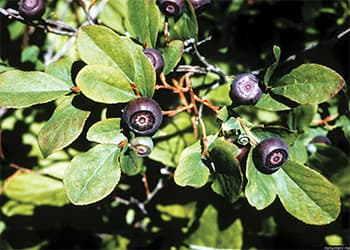
Western Huckleberry (Vaccinium membranaceum) is a multi-branched, evergreen bushy shrub, 1.5 to 15 ft. Leaves are thick, oval, glossy, and dark-green with serrated edges, with the underside dull and lighter in color. Flowers are pink to white. Fruit is a small, shiny, purple- to-black berry. Huckleberries make wonderful pies and jams. Western Huckleberry grows in hardiness zones 3-7 and the West region of the U.S.
While all of these are located in America, we don’t want to leave our overseas readers out of the loop. Countries like Canada and Australia are also abundant with delicious plants.
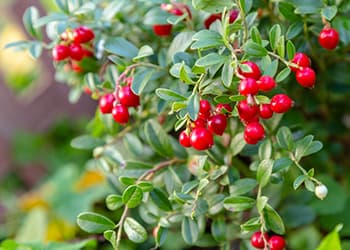 Lingon Berries (Vaccinium vitis-idaea) is a dwarfed shrub. Its leaves, which alternate along the stem, are evergreen, narrowly oval-shaped, and rounded with a small notch at the tip. The tops of the leaves have a sheen and the undersides are paler with black dots. Lingon berries are also called lowbush cranberries so you can use them in the same way you use cranberries. They grow in hardiness zone 3-8.
Lingon Berries (Vaccinium vitis-idaea) is a dwarfed shrub. Its leaves, which alternate along the stem, are evergreen, narrowly oval-shaped, and rounded with a small notch at the tip. The tops of the leaves have a sheen and the undersides are paler with black dots. Lingon berries are also called lowbush cranberries so you can use them in the same way you use cranberries. They grow in hardiness zone 3-8.
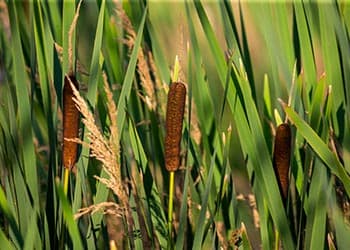 Cattails (Typha latifolia) You can easily recognize a cattail; it has a brown cigar-shaped head that stands atop a very long, stout stalk. Cattail shoots can be cooked and eaten.
Cattails (Typha latifolia) You can easily recognize a cattail; it has a brown cigar-shaped head that stands atop a very long, stout stalk. Cattail shoots can be cooked and eaten.
The pollen is also used as a spice. Cattails grow in hardiness zone 3-10.
⇒ Redbull of the Woods: The Energy Booster You Can Find in The Wild (Video)
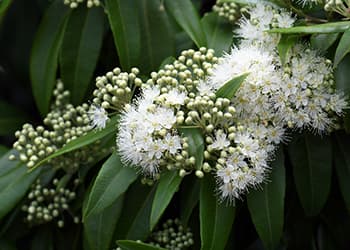 Lemon Myrtle Leaves (Backhousia citriodora) have dark green leaves, with white flower bunches in the summer.
Lemon Myrtle Leaves (Backhousia citriodora) have dark green leaves, with white flower bunches in the summer.
The leaves and flowers of lemon myrtle are used in tea blends and beverages, biscuits, breads, confectionery, pasta, syrups, liqueurs, flavored oils, packaged fish (salmon), and dipping and simmer sauces.
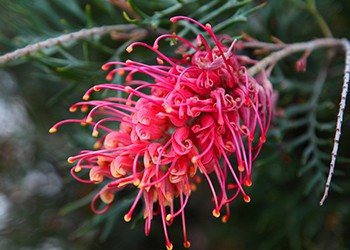
Spider Flower (Grevillea) are evergreen trees and shrubs with fine-textured leaves and long, thin curled flowers.
Flowers form in clusters and come in many colors including red, orange, yellow, pink, cream, and white.
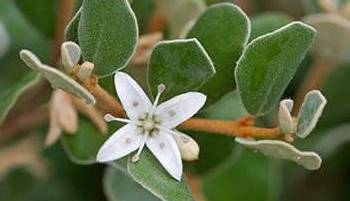
These flowers are abundant with delicious nectar, you can soak the flowers in hot water to make a sweet tea. Spider Flowers grow in hardiness zones 9-11
Correa (Correa Alba) is a shrub with round leaves and beautiful white flowers with four petals in a bell shape.
Correa is used to make aromatic tea. Correa grows in hardiness zones 8-11
Black Trumpet Mushrooms (Craterellus cornucopioides) look like black trumpets.
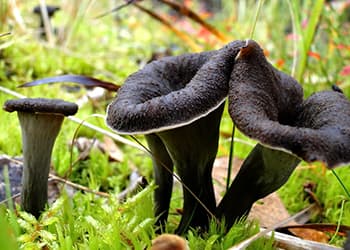
These mushrooms are vase or bull-horn shaped, and generally black, dark gray or dark brown in hue.
The underside of black trumpets lack true gills. They may be smooth, crinkled, or have linear groves that vaguely resemble gills, but are actually wrinkles in the mushroom’s surface, rather than separable gills.
They can be used in any mushroom dish, and are considered by many better tasting than their cousins the chanterelle. Black Trumpet Mushrooms grow in hardiness zones 3-6.
Whether it’s adding juniper berries to your apple cider or snacking on persimmons on a haunted trail we hope this list helps you find some lovely October treats. The best thing about foraging is you can have a delicious meal that you know where it comes from. What do you all plan to do with your October foraging finds?
You may also like:
 10 Medicinal Plants People Confuse With Their Poisonous Look-Alikes
10 Medicinal Plants People Confuse With Their Poisonous Look-Alikes
The Hidden Food Growing Fence (Video)
The Only 6 Medicinal Mushrooms You Need To Know









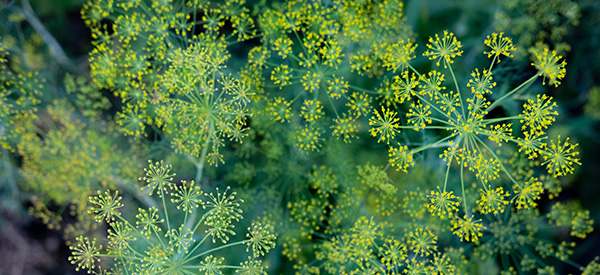
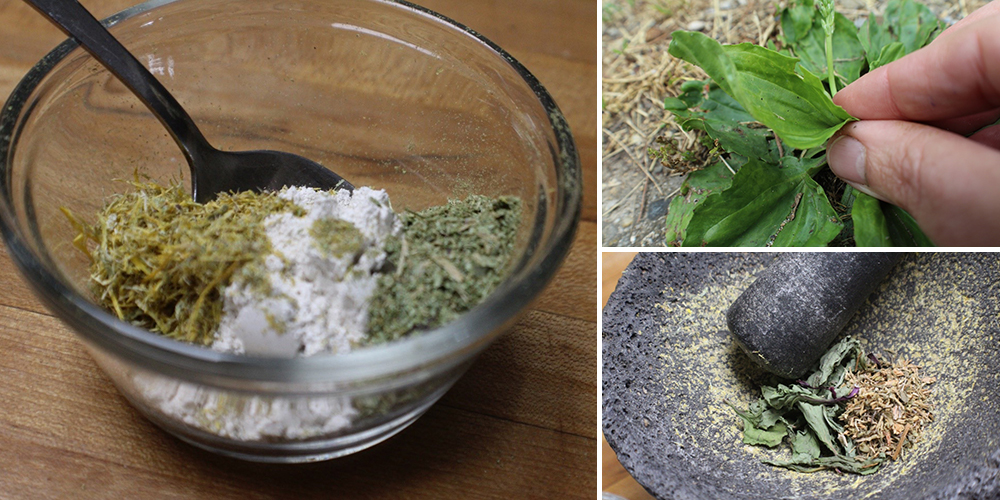
Black Walnuts, Hickory Nuts, Goldenrod, Curly Dock, Muscadines. All in harvest in Tennessee Zones 6 and 7.
Woohoo!
How can I make sure I will receive the hard copies of each book ordered?
Hello Kelly,
Thank you for your order! We have sent you an email with more information regarding your purchase.
Many blessings and good health!
Can I make a salve out of a tincture I made.
Hello Marv,
Yes, you a can add a few ml of tincture to your salve, but make sure to mix the ingredients thoroughly.
Many blessings and good health!
Wonderful info! Thank you! I found some mushrooms in my backyard and was dying to eat them, but wasn’t sure…so glad you offer your amazing material! #LoveEarth #EARTH #HEART
Hi Rose,
Thank you for your kind comment! We are happy to hear our article is helpful.
Many blessings and good health!
What do you have on Beauty Berries? They are all over my riding trail here in central NC
Hello Dawn,
Thank you for your question.
For many wild animals, including birds and deer, beautyberries are an essential food source. Humans can eat the berries, but in moderation. Although raw berries can be eaten, they are typically used to make jellies and wines.
Many blessings and good health!
Thank you!! We recently moved into Zone 5b which is in the far eastern nook of WV along the Virginia border in the mountains. The plants here are abundant and your books and emails have inspired me greatly. Thank you!! I am foraging many of these right now and plan to look for those I have yet to find!! Happy foraging everyone.
Hello Monica,
Thank you for sharing this! We are glad to hear our books and articles are helpful to you!
Many blessings and good health!
I live in Belgium Europe, it seems to be different from US and Canada and Australia. Sad, I bought the book yrs ago and it feels like I can’t do much with it. But none the less it’s a good book and love the info!
Hello Valeria,
Thank you so much for supporting our work!
Many of the plants depicted in our books can be found or grown in Europe as well.
We are happy to hear you enjoy the book.
Many blessings and good health!
I purchased your lost book of herbal remedies thinking it would come in book form however it was sent in electronically to my I pad I have now lost it completely I am not very good electronically and tried to save it but it does not seem to be in my I pad any more is it at all possible to get it in book form
Hello Jane,
Thank you so much for supporting our work! We have now sent you an email with all the information you need regarding your purchase.
Many blessings and good health!
Thank you for including Prickly Pear! I appreciate the inclusion of something from the desert. 🙂 Another fall desert forageable I recently discovered is desert hackberry! They are orange berries on a shrub.
Hello AP,
Thank you for your comment! That’s a great find indeed. You can either eat it raw, cooked, or even make a syrup.
Many blessings and good health!
I ordered The lost herb book and got the foragers guide. The offer that day it included 4 complain books. I want everything in book form. Please send the balance of my order.
Hello Elise,
Thank you so much for supporting our work! An email has been sent to you with more details regarding your order.
Many blessings and good health!
I just got back from AZ and noticed that the prickly pear pads are sometimes pink to purple, mostly those growing in the medians or in landscaped areas. Do they feed them something that changes their color, like for hydrangeas? I live in Indiana and many years ago got a start of a prickly pear that spread like crazy, covered in thousands of yellow blooms for the better part of the summer, so they aren’t just for the warmer regions.